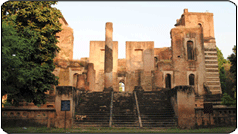Dilkusha Palace
Not Rome, not Athens, not Constantinople, not any city I have seen appears to me as striking and so beautiful as this. These lines about the city of Lucknow were written in March 1858 by William Howard Russell, the much travelled correspondent of The Times'.
Can you imagine that Russell had this beautiful view of the city from Dilkusha Kothi - a majestic building that had been then recently damaged by artillery fire during the dilly dallying fights between the Indian sepoys and the British forces during 1857-1858.
There is enough evidence of three heavy engagements that took place at Dilkusha. One on November 14, 1857, when the Commander-in-Chief of the British army in India, Colin Campbell captured it from the Indian sepoys in rebellion, secondly when the rebels took it back from the British, and thirdly on March 3, 1858 when it was recaptured by Campbell.
Campbell used it as a base for the final assault on Begum Hazrat Mahai who was ruling the State from Qaiser Bagh, when her son was crowned as the Waali-us-Saltanat (Guardian of the Kingdom) of Awadh at the tender age of eleven years in the absence of the King, Wajid Ali Shah, deposed by the British. Campbell collected a force of 50,000 men including 5,000 horsemen supported by eighty pieces of heavy artillery to launch the attack from Dilkusha Kothi that resulted in the defeat of the rebels (freedom fighters).
It was here at Dilkusha that General Havelock died on November 22, 1857 while the fighting was in progress. His body was taken to Aalam Bagh which was safe and in the occupation of the British, where he was buried. Later, Dilkusha Kothi was used as the residence of the General of the British Command Division. The area around Dilkusha was taken over in 1862 for establishing the new cantonment, when the old cantonment at Mandiaon was disbanded.
Situated at the eastern, end of the city, Dilkusha Kothi was built for the sixth Nawab of Awadh, Saadat Ali Khan in 1805. The design of this European style building was suggested by Gore Ousley, acting British Resident and a good friend of the Nawab. According to Rosie Llewellyn Jones (author of A Fatal Friendship) Dilkusha Chateau is almost an exact replica of Seaton Deiavel, an English building by Sir John Vanbrugh in Northumderland.
The Dilkusha Kothi was originally a three storeyed structure with a part basement. It had four ornamental octagonal towers with glazed pottery tops. The entrance was through an imposing flight of steps that led to a central doorway beneath a portico supported by tall pillars as high as the roof of the second storey. Probably imitating the Constantia built by Claude Martin, the Dilkusha Kothi too had female statues near the balustrades.
Dilkusha Kothi was mostly used as a hunting lodge by the Nawabs and Kings of Awadh, as there was plenty of game, like deer, in the surrounding woods. Being close to the river, it was a scenic spot that provided amusements for the Begums who quite often came here with the ladies of the royal household for picnics, specially in the summers, incidently, the palace did not have an exclusive zenana for women as in other Nawabi buildings. [The Bibiapur Kothi is situated very close to Dilkusha Kothi and in all probablity it was the place used as zenana for stay of ladies while the men stayed at Dilkusha Kothi].
King Naseer-ud-Din Haider wanted to take over the Residency for building a new spectacular palace on its high grounds and Dilkusha Kothi was offered to the British Resident as an alternative [which they did not accept]. Later King Wajid Ali Shah, during the early years of his rule, built another Kothi adjacent to Dilkusha and cleared the ground around it to hold military exercises for his troops. The British took- exception to this and the King was asked to abandon the exercises which left him dejected. Powerless, Wajid Ali Shah was compelled to abdicate by the British [and on his refusal to sign his abdication document, he was illegally deposed].
The ghostly ruins of Dilkusha Kothi remain today a dismal reminder of sacrifices made by the sepoys of Awadh, who along with the masses, launched a popular revolt against the British, which is known today as the first freedom struggle of India, that sowed the seeds of the ultimate struggle for Independence from British yoke for the country.
Source:
Hindustan Times, City Scan, A Time in History
Wednesday 20.8. 1997 — Dilkusha Kothi: Freedom's prime bastion

